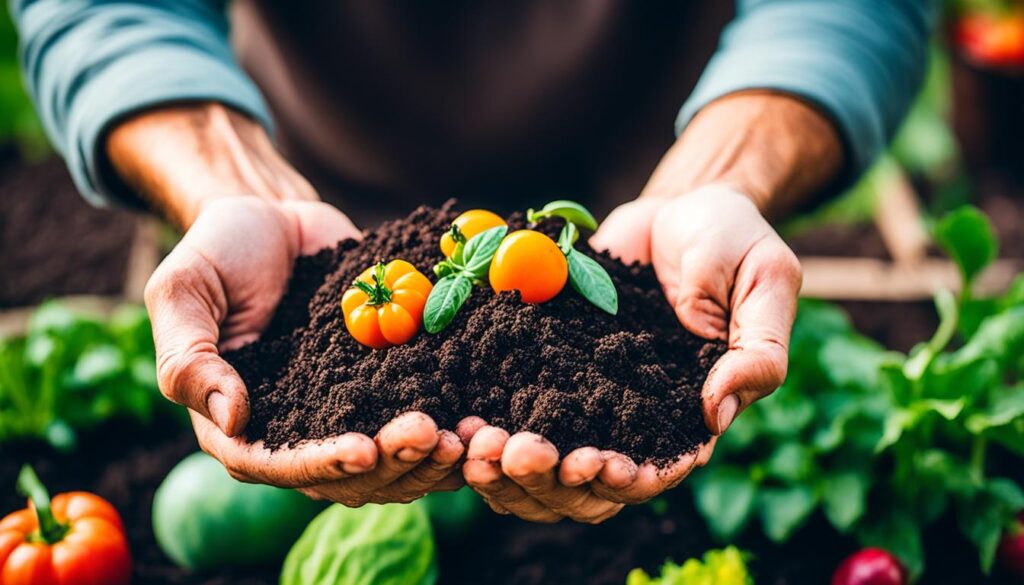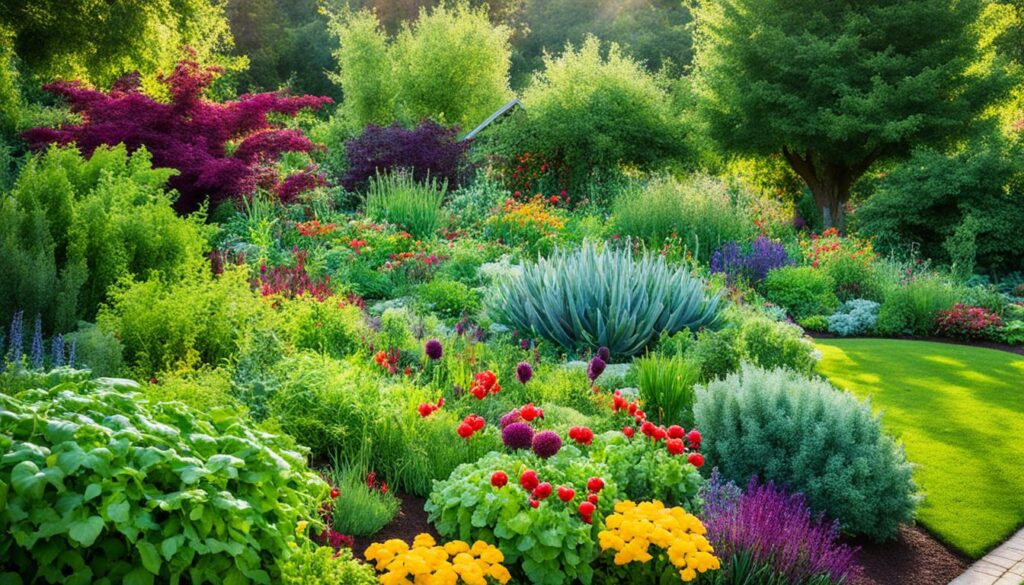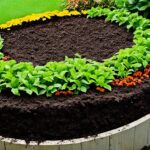No-Dig Gardening: Benefits and How to Start
Imagine a garden that grows easily, with few weeds, and full of life. This dream is what no-dig gardening is all about. It’s changing how we garden. We’ll look at its benefits and how to begin your own easy garden.
But first, let’s ask a big question: What if the secret to a great garden is working with nature, not against it? This idea is at the heart of no-dig gardening. It’s a new way of gardening that turns old ideas upside down.
Key Takeaways
- No-dig gardening is a sustainable way to improve soil without turning it over.
- This method cuts down on work, weeds, and helps plants grow healthier naturally.
- It works like nature’s ecosystem, making gardens easy to care for and full of life.
- Using no-dig gardening can make your soil better and healthier.
- Starting with no-dig gardening, like sheet mulching, can turn your yard into a green oasis.
Embracing Nature’s Ecosystem: The Principles of No-Dig Gardening
No-dig gardening is all about understanding the soil ecosystem. It’s full of life, from fungi to earthworms and beneficial microbes. By copying nature, gardeners make their soil better and grow strong, healthy gardens.
Soil is Life: Understanding the Soil Ecosystem
Soil is alive, not just a simple ground cover. It’s a complex mix of organisms that help plants grow. These include bacteria, fungi, and microbes that are key to nutrient cycling and keeping the soil healthy. No-dig gardening helps keep this ecosystem strong, giving plants the nutrients they need.
Mimicking Nature: The Art of No-Dig Gardening
No-dig gardening follows nature’s lead. It lets organic matter break down naturally, enriching the soil. This way, the soil stays healthy and plants grow better. By not tilling the soil, gardeners keep the soil’s life and networks that plants need to thrive.
“The soil is the great connector of our lives, the source and destination of all.” – Wendell Berry
Using no-dig gardening lets you improve your soil and grow a beautiful, organic garden. This method is good for the soil and helps you connect more with the earth.
Transforming Your Garden: The Sheet Mulching Technique
Starting with no-dig gardening means using the sheet mulching technique, also known as lasagna gardening. This method layers organic materials on top of your soil or lawn. It creates a perfect environment for plants to grow well.
Layering Organic Materials: The Lasagna Gardening Approach
Sheet mulching’s success comes from layering organic materials carefully. Start with cardboard or newspaper to block light and stop weeds. Then, add a thick layer of compost for nutrients and organic matter.
Keep adding layers of organic matter, like shredded leaves, straw, or aged manure. This creates a rich environment for your plants.
Compost: The Key to a Thriving No-Dig Garden
- Compost is crucial for a no-dig garden, bringing beneficial microorganisms and improving soil structure.
- Adding compost to your layers boosts the soil’s moisture retention and nutrient cycling.
- As the organic materials break down, they increase the soil’s organic matter. This makes the soil more fertile and healthy.
“The beauty of sheet mulching is that it allows you to transform even the most challenging soil into a thriving, nutrient-rich garden bed, without the need for arduous digging or tilling.”
The Bounty of No-Dig Gardening: Reduced Weeds and Healthier Plants
No-dig gardening can change your garden for the better. It leads to fewer weeds and healthier plants. By putting a thick, rich mulch on the soil, you stop weeds from growing.
Using cardboard or newspaper helps block light, so weed seeds can’t grow. The compost adds nutrients that help your plants thrive. As your plants grow, they crowd out weeds, making the soil less welcoming for them.
This means your garden will have healthier plants, fewer weeds, and richer soil. No-dig gardening lets you focus on your plants, not fighting weeds. It’s a way to take back your garden.
| Benefits of No-Dig Gardening | Traditional Tilling | No-Dig Approach |
|---|---|---|
| Weed Suppression | Frequent manual removal required | Thick mulch layer smothers weeds |
| Soil Fertility | Disrupts soil structure, depletes nutrients | Compost and organic matter enrich the soil |
| Plant Health | Vulnerable to pests and diseases | Thriving root systems and microbial communities |
Try no-dig gardening and see how your garden changes. You’ll have fewer weeds, healthier plants, and soil full of life. This sustainable method brings big rewards.
Unleashing Nature’s Power: The Ecosystem Engineers at Work
No-dig gardening thrives thanks to the many creatures in the soil ecosystem. These heroes, like worms, insects, and microbes, work hard to keep your garden’s soil healthy.
The Unsung Heroes: Worms, Insects, and Microbes
Worms are key “ecosystem engineers.” They dig tunnels, letting air and water deep into the soil. Their waste, or castings, adds nutrients and improves soil.
Insects, like beetles and ants, are vital too. They break down organic matter and release nutrients for plants. Many insects also eat pests, keeping your garden balanced.
Underground, microbes like bacteria and fungi are busy. They turn organic stuff into nutrients for plants. They also help soil structure and support beneficial fungi that help plants grow.
| Organism | Role in the Soil Ecosystem |
|---|---|
| Worms | Aerate soil, improve structure, and provide nutrient-rich castings |
| Insects | Decompose organic matter, prey on pests, and maintain balance |
| Microbes | Break down organic materials, release nutrients, and improve soil structure |
Supporting these “ecosystem engineers” makes your no-dig garden thrive. It becomes a self-sustaining system that gives you lots of healthy, nutrient-rich food.
No-Dig Gardening: A Sustainable Solution for Thriving Gardens
Embracing sustainable gardening, no-dig gardening is an eco-friendly way to grow gardens. It reduces soil disturbance and uses natural processes. This method helps with carbon sequestration and climate change mitigation. It also makes gardens more fertile and resilient to drought and extreme weather.
No-dig gardening sees soil as a living ecosystem full of microorganisms, insects, and worms. By keeping this balance, gardeners create a self-sustaining garden. This method needs less fertilizers and pesticides, helping plants and the environment.
- Reduced carbon footprint: No-dig gardening cuts down soil disturbance, which traps carbon in the soil and fights climate change.
- Improved soil health: It boosts the soil’s natural fertility, making it better at holding water and providing nutrients for plants.
- Increased biodiversity: The undisturbed soil is a great home for beneficial organisms, creating a balanced garden ecosystem.
No-dig gardening is a sustainable way to make gardens lush, productive, and good for the environment. By using this method, you help your soil, plants, and the planet.
“Sustainable gardening is not just about growing food or flowers – it’s about nurturing the entire ecosystem and leaving the land in a better state than we found it.”
| Benefits of No-Dig Gardening | Traditional Gardening |
|---|---|
| Improved soil structure and fertility | Soil degradation and loss of organic matter |
| Increased water-holding capacity and drought resilience | Higher irrigation and water usage |
| Enhanced biodiversity and ecosystem balance | Disruption of natural habitats and reduced biodiversity |
| Lower carbon footprint and climate change mitigation | Higher carbon emissions and contribution to climate change |
Nurturing the Soil, Nurturing Yourself: The Mental and Physical Benefits
No-dig gardening offers more than just practical benefits. It can deeply affect your mental and physical health. Caring for a garden can make you feel closer to nature. It encourages mindfulness and stress relief. Plus, it’s a great way to get some exercise.
Gardening is good for your mental health. Digging, planting, and weeding can make you focus on the now. This helps reduce anxiety and makes you feel happier.
Gardening also boosts your physical health. The exercise and sunlight can improve your heart health, muscle strength, and flexibility. Eating fresh produce from your garden can make your diet more varied and tasty. This supports your overall well-being.
“Gardening is the purest of human pleasures.” – Francis Bacon
Choosing no-dig gardening helps you grow a beautiful garden and a strong connection to nature. Taking care of the soil helps your mental and physical health. It makes gardening a rewarding and refreshing activity.

no-dig gardening: A Low-Maintenance Approach to Gardening Bliss
Embracing no-dig gardening means saying goodbye to hard gardening tasks. This new way of gardening saves your time and energy. It lets you enjoy the best parts of gardening.
No-dig gardening is easy to keep up with. You don’t need to till, weed, or lift heavy things often. This makes your garden a beautiful place with little work needed to keep it looking great. The mulch stops weeds, and the soil works hard on its own, needing almost no help from you.
| Benefits of No-Dig Gardening | Traditional Gardening |
|---|---|
| Reduced effort and time investment | Constant weeding, tilling, and manual labor |
| Healthy, nutrient-rich soil | Depleted, compacted soil |
| Thriving, low-maintenance plants | Struggling, high-maintenance plants |
Join the effortless gardening movement and find the real bliss of a low-maintenance, time-saving garden. Start with no-dig gardening and turn your outdoor area into a lush, lively space with little work.
“No-dig gardening is the ultimate in low-maintenance and reduced effort gardening. It’s a true time-saving and effortless way to create a thriving, productive garden.”
Seasonal Transitions: Adapting No-Dig Gardening to Your Climate
No-dig gardening works well in many climates. As seasons change, simple tweaks can keep your garden thriving all year. Whether you’re getting ready for spring or enjoying summer’s harvest, these tips will help your no-dig garden flourish.
Spring Awakening: Preparing Your No-Dig Garden
When spring comes, wake up your garden gently. Start by adding compost to your beds to make the soil rich and ready for new growth. Watch out for any frost in your area and protect your seedlings. With some prep work, your garden will be ready for a great spring harvest.
Summer Abundance: Reaping the Rewards of No-Dig Gardening
Summer is a time to celebrate in your no-dig garden. The organic layers you built up will help keep the soil moist and weed-free. This lets you enjoy your garden’s bounty without much work, enjoying the harvests your garden provides.
No matter the season, no-dig gardening is a sustainable way to grow your dream garden. By using seasonal adaptations and climate-specific techniques, your no-dig beds will do well from spring preparation to summer harvests.

Conclusion: Embracing a New Gardening Philosophy
No-dig gardening changes how you grow food and plants. It means working with nature instead of fighting it. This way, you get gardens that are healthy, easy to care for, and good for the planet.
This method makes you connect more with nature and live more sustainably. It leads to lots of food and a stronger bond with the earth. It’s a new way of gardening that’s good for you and the planet.
Switching to no-dig gardening means using practices that help the soil’s ecosystem. You’ll see your garden do well without needing a lot of work. This approach makes you a caretaker of the earth, enjoying the mental and physical perks of a beautiful garden.
Starting with no-dig gardening is a journey of learning and wonder. You’ll see how nature’s design is beautiful and strong. By going this way, you’ll change your garden and gain a new respect for all living things. Start this path and see the amazing results of a sustainable garden oasis.
FAQ
What is no-dig gardening?
What are the key benefits of no-dig gardening?
How does no-dig gardening work?
What is the foundation of no-dig gardening?
How does no-dig gardening suppress weed growth?
What role do soil organisms play in no-dig gardening?
How does no-dig gardening align with principles of sustainability?
What are the mental and physical benefits of no-dig gardening?
What is the low-maintenance nature of no-dig gardening?
How can no-dig gardening be adapted to different climates?
Source Links
- https://www.charlesdowding.co.uk/post/the-amazing-benefits-of-no-dig-no-till – The amazing benefits of no dig, no till
- https://www.saveur.com/culture/no-dig-gardening/ – I (Basically) Stopped Weeding Thanks to This Game-Changing Gardening Method
- https://www.bhg.com/gardening/how-to-garden/no-dig-gardening/ – How a No-Dig Garden Leads to Healthier Soil and Thriving Plants
- 10 Must-Have Blooms for Your 2025 Garden
- The Health Advantages of Gardening You Need to Know
- How to Create a Small Vegetable Garden Layout Plan: A Beginner’s Guide
- DIY Garden Projects for Small Spaces: Upcycling Ideas to Maximize Your Garden
- Watering Techniques for Small Gardens: Ensuring Your Plants Thrive
- Small Border Plants for Landscaping: Adding Beauty and Functionality to Your Garden
- Year-Round Small Space Gardening: Seasonal Planting Tips for Maximum Harvest
- Essential Tools for Small-Space Gardening: What You Really Need
- The Ultimate Guide to Container Vegetables: What to Grow in Small Spaces
- Budget-Friendly Gardening: How to Create a Thriving Garden on a Tight Budget
- How to Optimize Sunlight in Small Gardens: Tips for Better Plant Growth
- DIY Vertical Planters: Creative Ideas for Small Space Gardening
- Companion Planting for Small Vegetable Gardens: Boost Growth and Deter Pests
- Container Gardening Essentials: Choosing the Right Pots, Soil, and Plants
- Vertical Gardening Techniques: Maximizing Your Small Space with Climbers and Vines
- How to Build a Raised Bed Garden in a Small Backyard: Step-by-Step Guide
- The Best Vegetables for Small-Space Gardens: High-Yield Varieties You Need to Grow
- Smart Vegetable Garden Layouts for Small Spaces: Maximizing Your Green Thumb in Compact Areas
- 40. Best Practices for Managing a Sustainable Garden Year-Round
- Building a Wildlife Pond for Biodiversity
- Advanced Techniques in Sustainable Gardening
- How to Create a No-Till Garden
- The Mental Health Benefits of Gardening
- Using Technology to Enhance Sustainable Gardening
- Getting Certified Organic: Steps and Benefits

Leave a Reply